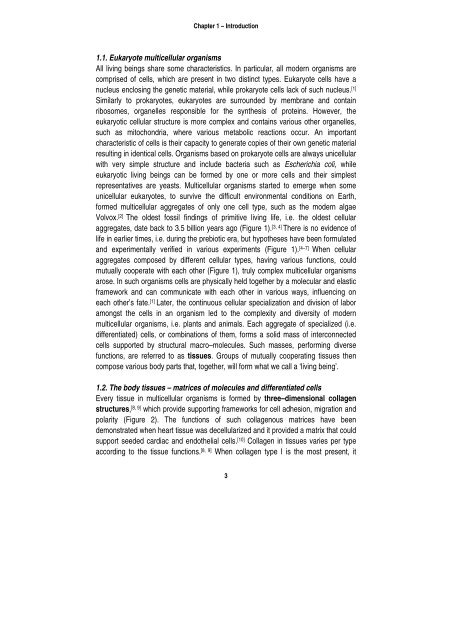Barbieri Thesis - BioMedical Materials program (BMM)
Barbieri Thesis - BioMedical Materials program (BMM)
Barbieri Thesis - BioMedical Materials program (BMM)
Create successful ePaper yourself
Turn your PDF publications into a flip-book with our unique Google optimized e-Paper software.
Chapter 1 – Introduction<br />
1.1. Eukaryote multicellular organisms<br />
All living beings share some characteristics. In particular, all modern organisms are<br />
comprised of cells, which are present in two distinct types. Eukaryote cells have a<br />
nucleus enclosing the genetic material, while prokaryote cells lack of such nucleus. [1]<br />
Similarly to prokaryotes, eukaryotes are surrounded by membrane and contain<br />
ribosomes, organelles responsible for the synthesis of proteins. However, the<br />
eukaryotic cellular structure is more complex and contains various other organelles,<br />
such as mitochondria, where various metabolic reactions occur. An important<br />
characteristic of cells is their capacity to generate copies of their own genetic material<br />
resulting in identical cells. Organisms based on prokaryote cells are always unicellular<br />
with very simple structure and include bacteria such as Escherichia coli, while<br />
eukaryotic living beings can be formed by one or more cells and their simplest<br />
representatives are yeasts. Multicellular organisms started to emerge when some<br />
unicellular eukaryotes, to survive the difficult environmental conditions on Earth,<br />
formed multicellular aggregates of only one cell type, such as the modern algae<br />
Volvox. [2] The oldest fossil findings of primitive living life, i.e. the oldest cellular<br />
aggregates, date back to 3.5 billion years ago (Figure 1). [3, 4] There is no evidence of<br />
life in earlier times, i.e. during the prebiotic era, but hypotheses have been formulated<br />
and experimentally verified in various experiments (Figure 1). [4–7] When cellular<br />
aggregates composed by different cellular types, having various functions, could<br />
mutually cooperate with each other (Figure 1), truly complex multicellular organisms<br />
arose. In such organisms cells are physically held together by a molecular and elastic<br />
framework and can communicate with each other in various ways, influencing on<br />
each other’s fate. [1] Later, the continuous cellular specialization and division of labor<br />
amongst the cells in an organism led to the complexity and diversity of modern<br />
multicellular organisms, i.e. plants and animals. Each aggregate of specialized (i.e.<br />
differentiated) cells, or combinations of them, forms a solid mass of interconnected<br />
cells supported by structural macro–molecules. Such masses, performing diverse<br />
functions, are referred to as tissues. Groups of mutually cooperating tissues then<br />
compose various body parts that, together, will form what we call a ‘living being’.<br />
1.2. The body tissues – matrices of molecules and differentiated cells<br />
Every tissue in multicellular organisms is formed by three–dimensional collagen<br />
structures, [8, 9] which provide supporting frameworks for cell adhesion, migration and<br />
polarity (Figure 2). The functions of such collagenous matrices have been<br />
demonstrated when heart tissue was decellularized and it provided a matrix that could<br />
support seeded cardiac and endothelial cells. [10] Collagen in tissues varies per type<br />
according to the tissue functions. [8, 9] When collagen type I is the most present, it<br />
3





